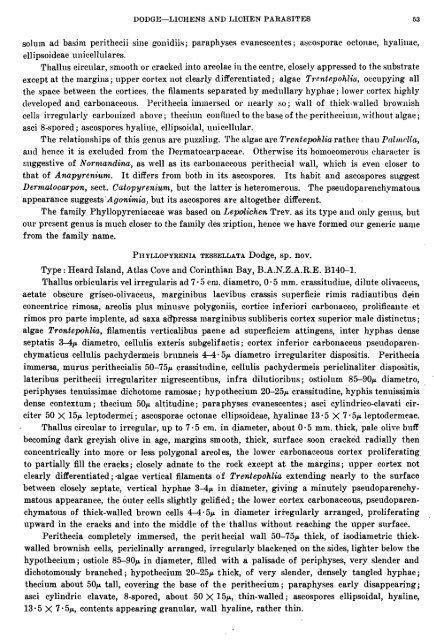You also want an ePaper? Increase the reach of your titles
YUMPU automatically turns print PDFs into web optimized ePapers that Google loves.
DODGE-<strong><strong>LICHEN</strong>S</strong> <strong>AND</strong> <strong>LICHEN</strong> PARASITE6 53<br />
soluln ad basim perithecii sine gonidiis; paraphyses evanescentes; ascosporae octonae, hyali~iae,<br />
ellipsoideae unicellulares.<br />
Thallus circular, smooth or craclrecl into areolae in the centre, closely appressed to the substrate<br />
except at the margins; upper cortex not clearly differentiated ; algae Trcnt~pohlia, occupying all<br />
the space between the cortices, the filaments separated by medullary hyphae; lower cortex highly<br />
d(.veloped anil carbonaceous. Perithecia immersecl or nearly so; of thiclr-walled brownish<br />
cells irregularly carbollized above ; theci~un colifillecl to the base of the perithecium, without algae ;<br />
asci 8-spored; ascospores hyaline, ellipsoiclal, ullicellular.<br />
The relationships of this genus are puzzling. The algae are I'rentepohlia rather than Paln~t~lln,<br />
and hence it is excluded from the Dermatocarpaceae. Otherwise its homoeomerous caharauter is<br />
snggestive of Nornaandina, as well as its carbonaceous perithecial wall, which is even closer to<br />
that of Anapyrcniunt. It differs from both in its ascospores. Its habit and ascospores suggest<br />
Dernaatocarpon, sect. Catopyrenium, but the latter is heteromerous. The pseudoparenchymatous<br />
appearance suggests'Agonimia, but its ascospores are altogether different.<br />
The family Phyllopyreniaceae was based on Lepolichen Treu. as its type ancl ollly gelms, but<br />
our present genus is much closer to the family des :ription, hence we have formed our generic llallle<br />
from the family name.<br />
PIIYLLOPYRENIA TESSELLATA Dodge, sp. nov.<br />
Type : Heard Island, Atlas Cove and Corinthian Bay, B.A.N.Z.A.R.E. B140-1.<br />
Thallus orbicularis vel irregularis ad 7.5 cm. diametro, 0-5 mm. crassitudine, dilute olivaceus,<br />
aetate obscure griseo-olivaceus, marginibus laevibus crassis superficie rimis radiantibus dein<br />
concentrice rimosa, areolis plus minusve polygoniis, cortice inferiori carbonaceo, prolificante et<br />
rimos pro parte implente, ad saxa aQressa marginibns subliberis cortex superior male distinctus ;<br />
algae Trmtepohlia, filamentis rerticalibus paene ad superficiem attingens, inter hyphas dense<br />
septatis 3-4p diametro, cellulis exteris subgelifactis; cortex inferior carborlaceus pseudoparen-<br />
chymaticus cellulis pachydermeis brunneis 4-4-5p diametro irregulariter dispositis. Perithecia<br />
immersa, murus perithecialis 50-75p crassitndine, cellulis pachydermeis periclinaliter dispositis,<br />
lateribus perithecii irregulariter nigrescentibus, infra dilutioribus; ostiolum 85-90p diametro,<br />
periphyses tenuissimae dichotome ramosae; hypothecium 20-25p craesitudine, hyphis tenuissimis<br />
dense contextum; thecium 50cr altitudine; paraphyses evanescentes; asci cylindrico-clavati cir-<br />
citer 50 X 15p leptodermei; ascosporae octonae ellipsoideae, hyalinae 13.5 X 7.5p leptodermeae.<br />
Thallus circular to irregular, up to 7.5 cm. in diameter, about 0.5 mm. thick, pale olil-e buff<br />
becoming dark greyish olive in age, margins smooth, thick, surface soon cracked radially then<br />
concentrically into more or less polygonal areoles, the lower carbonaceous cortex proliferating<br />
to partially fill the cracks; closely adnate to the rock except at the margins; upper cortex not<br />
clearly differentiated ; -algae vertical filaments of Trentepohlia extending nearly to the surface<br />
between closely septate, vertical hyphae 34p in diameter, giving a minutely pseudoparenchy-<br />
matous appearance, the outer cells slightly gelified; the lower cortex carbonaceous, pseudoparen-<br />
chymatous of thick-walled brown cells 4-4.5p in diameter irregularly arranged, proliferating<br />
upward in the cracks and into the middle of the thallus without reaching the upper surface.<br />
Perithecia completely immersed, the perit hecial wall 50-75cr thick, of isodiametric thick-<br />
walled brownish cells, periclinally arranged, irregularly blacken-ed on the sides, lighter below the<br />
hypothecium; ostiole 85-9OP in diameter, filled with a palisade of periphyses, very slender and<br />
dichotomously branched ; hypothecium 20-25p thick, of very slender, densely tangled hyphae ;<br />
thecium about 5OP tall, covering the base of the perithecium; paraphyses early disappearing;<br />
asci cylindric clavate, 8-spored, about 50 X 15cr, thin-walled; ascospores ellipsoidal, hyaline,<br />
13.5 X 7.5p, contents appearing granular, wall hyaIine, rather thin.

















